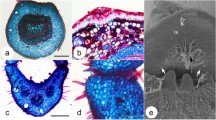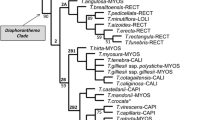Abstract
Lychnophorinae occurs mainly in campos rupestres and cerrados of the Cerrado Domain (Brazil) and are species subject to fire occurrences and intense solar radiation, occupying acid and well-drained soils. Informative characters on the taxonomy of this subtribe were studied considering the leaf and stem morphology and anatomy. In addition, putative synapomorphies and features that probably determined the success of these species in occupying these habitats were identified. Samples of leaves and stems of 52 species were analyzed using usual techniques in plant anatomy. The reconstruction of ancestral states of characters was made in parsimony analysis using the phylogeny established for Lychnophorinae. The analyses indicated two distinct types of stems and a wide variation in foliar features, with the possible occurrence of three synapomorphies for the stems and 11 for the leaves. Adaptive pressures of restricted environments, where most species live, probably directed the evolution of morphological and anatomical diversity in Lychnophorinae.


















Similar content being viewed by others
Literature Cited
Alcorn, S. M. & P. A. Ark . 1953. Softening paraffin-embedded plant tissues. Stain Technology 28: 55–56.
Alves, R. J. & N. G. Silva . 2011. O fogo é sempre um vilão nos campos rupestres? Biodiversidade Brasileira 1:120–127.
Baruch, Z. 1979. Elevation differentiation in Espeletia schultzii (Compositae), a giant rosette plant of the venezuelan Paramos. Ecology 60: 85–98.
——— & A. P. Smith . 1979. Morphological and physiological correlates of niche breadth in two species of Espeletia (Compositae) in the Venezuelan Andes. Oecologia 38: 71–82.
Beierkuhnlein, C. & A. Jentsch . 2005. Ecological importance of species diversity. In: R. J. Henry (ed.). Diversity and evolution genotypic and phenotypic variation in higher plants. Wallingford: CABI publishing, 249–285.
Coile, N. C. & S. B. Jones Jr . 1981. Lychnophora (Compositae: Vernonieae), a genus endemic to the brazilian planalto. Brittonia 33: 528–542.
Cox, G., C. R. Hawes, L. Van der Lubbe & B. E. Juniper . 1987. High-voltage electron microscopy of whole, critical-point dried plant cells. 2. Cytoskeletal structures and plastid motility in Selaginella. Protoplasma 140: 173–186.
Cuatrecasas, J. 1933. Plantae colombianae novae. Trabajos del Museo de Ciencias Naturales - Serie Botanica 33: 1–158.
——— 2013. A systematic study of the subtribe Espeletiinae (Heliantheae, Asteraceae). New York, New York Botanical Garden Press.
Dantas, V. L. & M. A. Batalha . 2011. Vegetation structure: fine scale relationships with soil in a cerrado site. Flora 206: 341–346.
De Pinna, M. C. C . 1991. Concepts and tests of homology in the cladistic paradigm. Cladistics 7: 367–394.
Echternacht, L., M. Trovó, C. T. Oliveira & J. R. Pirani . 2011. Areas of endemism in the Espinhaço range in Minas Gerais, Brazil. Flora 206:782–791.
Fahn, A. & D. F. Cutler. 1992. Xerophytes. Berlin/Stuttgart, Gebrüder Borntraeger.
Fujinami, R., I. Yoshihama & R. Imaichi . 2011. Dimorphic chloroplasts in the epidermis of Podostemoideae, a subfamily of the unique aquatic angiosperm family Podostemaceae. Journal of Plant Research 124: 601–605.
Funk, V. A., A. Susanna, T. F. Stuessy & H. Robinson . 2009. Classification of Compositae. In: V. A. Funk, A. Susanna, T. F. Stuessy & R. J. Bayer (eds). Systematics, Evolution and Biogeography of Compositae. Vienna, Austria: International Association for Plant Taxonomy (IAPT), 171–189.
Gardoni, L. C. P., R. M. S. Isaias & F. H. A. Vale . 2007. Morfologia e anatomia foliar de três morfotipos de Marcetia taxifolia (A. St.-Hil.) DC. (Melastomataceae) na Serra do Cipó, MG. Revista Brasileira de Botânica 30: 487–500.
Giulietti, A. M., J. R. Pirani & R. M. Harley . 1997. Espinhaço Range Region. In: S. D. Davis, V. H. Heywood, O. Herrera-MacBride, J. Villa-Lobos & A. C. Hamilton (eds). Centres of Plant Diversity: a guide and strategy for their conservation. Vol. 3: The Americas. Cambridge, WWF-IUCN, 397–404.
Givnish, T. J., R. W. McDiarmid & W. R. Buck . 1986. Fire adaptation in Neblinaria celiae (Theaceae), a high-elevation rosette shrub endemic to a wet equatorial tepui. Oecologia 70: 481–485.
Goodland, R. & M. G. Ferri . 1979. Ecologia do Cerrado. São Paulo, Editora da Universidade de São Paulo.
Gregory, M. & P. Baas. 1989. A survey of mucilage cells in vegetative organs of the dicotyledons. Israel Journal of Botany 38:125–174.
Hughes, J. & M. E. McCull . 1975. The use of an optical brightener in the study of plant structure. Stain Technology 50: 319–329.
Jensen, W. A. 1962. Botanical histochemistry: principle and practice. San Francisco, W. H. Freeman.
Karnovsky, M. J. 1965. A Formaldehyde-glutaraldehyde fixative of high osmolality for use in electron microscopy. The Journal of cell Biology 27: 137a-138a.
Keeley, S. C. & H. Robinson. 2009. Vernonieae. In: V. A. Funk, A. Susanna, T. F. Stuessy & R. J. Bayer (eds). Systematics, evolution and biogeography of compositae. Michigan, Sheridan books, 439–469.
———, Z. H. Forsman & R. Chan . 2007. A phylogeny of the “evil tribe” (Vernonieae: Compositae) reveals old/new world long distance dispersal: support from separate and combined congruent datasets (trnL-F, ndhF, ITS). Molecular Phylogenetics and Evolution 44: 89–103.
Kriebel, R., F. A. Michelangeli & L. M. Kelly . 2015. Discovery of unusual anatomical and continuous characters in the evolutionary history of Conostegia (Miconieae: Melastomataceae). Molecular Phylogenetics and Evolution 82: 289–313.
Loeuille, B. 2011. Towards a phylogenetic classification of Lychnophorinae (Asteraceae: Vernonieae). Tese. Universidade de São Paulo, São Paulo, Brasil.
———, S. C. Keeley & J. R. Pirani. 2015a. Systematics and evolution of syncephaly in American Vernonieae (Asteraceae) with emphasis on the Brazilian subtribe Lychnophorinae. Systematic Botany 40: 286–298.
———, J. Semir, L. G. Lohmann & J. R. Pirani . 2015b. A phylogenetic analysis of Lychnophorinae (Asteraceae: Vernonieae) based on molecular and morphological data. Systematic Botany 40: 299–315.
Luque, R. & N. L. Menezes . 2003. Anatomia foliar de Lychnophora Mart.(Vernonieae: Asteraceae). Plantula 3: 117–128
———, ——— & J. Semir. 1999. Estructura primaria del tallo de Lychnophora Mart.(Vernonieae: Asteraceae). Plantula 2: 141–152
Lusa, M. G., B. Appezzato-da-Glória, B. Loeuille, G. Bartoli & D. Ciccarelli . 2014. Functional groups in Lychnophorinae (Asteraceae: Vernonieae) based on morphological and anatomical traits. Australian Journal of Botany 62: 150–163.
———, E. C. Cardoso, S. R. Machado & B. Appezzato-da-Glória . 2015. Trichomes related to an unusual method of water retention and protection of the stem apex in an arid zone perennial species. AoB PLANTS 7: plu088.
———, M. E. P. Martucci, B. Loeuille, L. Gobbo-Neto, B. Appezzato-da-Glória & F. B. Da Costa . (2016). Characterization and evolution of secondary metabolites in Brazilian Vernonieae (Asteraceae) assessed by LC-MS fingerprinting. The Botanical Journal of the Linnean Society 182(3): 594–611.
Maddison, W. P. & D. R. Maddison. 2014. Mesquite: a modular system for evolutionary analysis. http://mesquiteproject.org.
Mello-Silva, R . 1990. Morphological and anatomical differentiation of Vellozia hirsuta populations (Velloziaceae). Plant Systematics and Evolution 173: 197–208.
Melo-de-Pinna, G. F. A. 2004. Anatomia foliar de Richterago Kuntze (Mutisieae, Asteraceae). Acta botanica brasilica 18: 591–600.
Minelli, A . 1993. Biological systematics: the state of the art. London, Chapman & Hall, 3–43.
Nakajima, J. N., A. M. Teles, M. Ritter, C. A. Mondin, M. Dematteis, G. Heiden, X. B. Borges, V. L. Rivera, J. B. A. Bringer Jr, M. Saavedra, R. de-Cássia-Araújo-Pereira & M. R. C. Sales-de-Melo . 2009. Asteraceae. In: A. M. Giulietti, (ed). Plantas raras do Brasil: Conservação Internacional. Belo Horizonte. Universidade Estadual de Feira de Santana, 76–89.
———, M. Dematteis, B. Loeuille, et al. 2013. Asteraceae. In: G. Martinelli & M. A. Moraes (eds). Livro vermelho da flora do Brasil. Rio de Janeiro, Instituto de Pesquisas Jardim Botânico do Rio de Janeiro, 203–286.
Nogueira, A., J. H. L. El Ottra, E. Guimarães, S. R. Machado & L. G. Lohmann . 2013. Trichome structure and evolution in Neotropical lianas. Annals of Botany 112: 1331–1350.
Oliveira, R. S., A. Abrahão, C. Pereira, G. S. Teodoro, M. Brum, S. Alcantara & H. Lambers . 2016. Ecophysiology of Campos Rupestres plants. In: G.W. Fernandes (ed). Ecology and conservation of mountaintop grasslands in Brazil. Cham, Springer International Publishing Switzerland, 227–272.
Pace, M. R. & V. Angyalossy . 2013. Wood anatomy and evolution: a case study in the Bignoniaceae. International Journal of Plant Sciences 174: 1014–1048.
———, L. G. Lohmann & V. Angyalossy . 2011. Evolution of disparity between the regular and variant phloem in Bignonieae (Bignoniaceae). American Journal of Botany 98: 602–618.
Panero, J. L., S. E. Freire, L. A. Espinar, B. S. Crozier, G. E. Barboza & J. J. Cantero . 2014. Resolution of deep nodes yields an improved backbone phylogeny and a new basal lineage to study early evolution of Asteraceae. Molecular phylogenetics and evolution 80: 43–53.
Rapini, A., P. L. Ribeiro, S. Lambert & J. R. Pirani . 2008. A flora dos campos rupestres da Cadeia do Espinhaço. Megadiversidade 4: 15–23.
Ratter, J. A., J. F. Ribeiro & S. Bridgewater . 1997. The Brazilian cerrado vegetation and threats to its biodiversity. Annals of Botany 80: 223–230.
Sajo, M. G., M. G. L. Wanderley & L. M. Carvalho . 1995. Caracterização anatômica foliar para 14 espécies de Xyris L. (Xyridaceae) da Serra do Cipó, MG, Brasil. Acta Botanica Brasilica 9: 101–114.
Sakai, W. S . 1973. Simple method for differential staining of paraffin embedded plant material using toluidine blue O. Stain Technology 48: 247–249.
Sakurai, N., K. Domoto & S. Takagi . 2005. Blue-light-induced reorganization of the actin cytoskeleton and the avoidance response of chloroplasts in epidermal cells of Vallisneria gigantea. Planta 221: 66–74.
Scatena, V., A. Giulietti, E. Borba & C. van den Berg . 2005. Anatomy of Brazilian Eriocaulaceae: correlation with taxonomy and habitat using multivariate analyses. Plant Systematics and Evolution 253: 1–22.
Scotland, R. & R. T. Pennington . 2000. Homology and systematics: Coding characters for phylogenetic analysis. Systematics association special volumes. Boca Raton: CRC Press.
Simon, M. F. & T. Pennington . 2012. Evidence for adaptation to fire regimes in the tropical savannas of the Brazilian Cerrado. International Journal of Plant Sciences 173:711–23.
———, R. Grether, L. P. Queiroz, C. Skema, R. T. Pennington & C. E. Hughes. 2009. Recent assembly of the cerrado, a neotropical plant diversity hotspot, by in situ evolution of adaptations to fire. Proceedings of the National Academy of science 106: 20.359–20.364.
Skelton, R. P., J. J. Midgley, J. M. Nyaga, S. D. Johnson & M. D. Cramer. 2012. Is leaf pubescence of Cape Proteaceae a xeromorphic or radiation-protective trait? Australian Journal of Botany 60: 104–113.
Smith, A. & T. Young . 1987. Tropical alpine plant ecology. Annual Review of Ecology and Systematics 18: 137–158.
Turner, I. M . 1994. Sclerophylly - primarily protective? Functional Ecology 8: 669–675.
Werker, E . 2000. Trichome diversity and development: Advances in botanical research incorporating advances in Plant Pathology 31: 1–35.
Zwieniecki M. A. & C. K. Boyce . 2014. Evolution of a unique anatomical precision in angiosperm leaf venation lifts constraints on vascular plant ecology. Proceedings of the Royal Society of London B: Biological Sciences 281: 20132829.
Acknowledgements
We thank the IEF, MG, Brazil, for granting permission and facilities to collect plant material for this study. This work was supported by the National Council for Scientific and Technological Development (CNPq) - grants [Proc. n° 302776/2010-9] and the São Paulo Council for Research (FAPESP) - financial support [Thematic Project Proc. no. 2010/51454-3] and grants for the first author [Proc. no. 2010/02085-5].
Author information
Authors and Affiliations
Corresponding author
Appendix
Appendix
Rights and permissions
About this article
Cite this article
Lusa, M.G., Loeuille, B.F.P., Ciccarelli, D. et al. Evolution of Stem and Leaf Structural Diversity: a Case Study in Lychnophorinae (Asteraceae). Bot. Rev. 84, 203–241 (2018). https://doi.org/10.1007/s12229-017-9191-4
Published:
Issue Date:
DOI: https://doi.org/10.1007/s12229-017-9191-4




